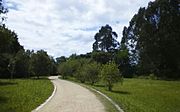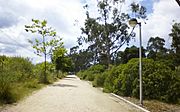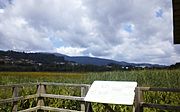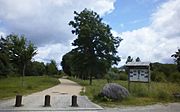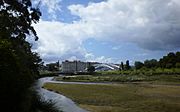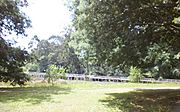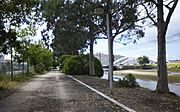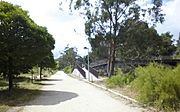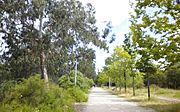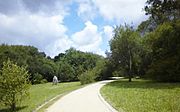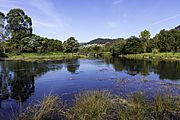Marismas de Alba Natural Park facts for kids
Quick facts for kids Parque de las Marismas de Alba |
|
|---|---|
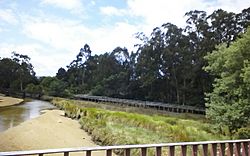 |
|
| Location | Pontevedra, Spain |
| Area | 0.67 km2 (165.56 acres) |
| Created | 2000 |
| Operated by | Municipality of Pontevedra |
| Status | Public park |
The Natural Park of the Marismas de Alba is a special green space in Pontevedra, Spain. It's also known as the Alba Marsh or the Xunqueira de Alba (which means "rush field" in Galician). This park is one of the few wetlands in the Ria de Pontevedra.
It's a fantastic place for walking, cycling, and exploring nature. You can see many different animals and plants here.
Contents
Where is the Park?
The park is located where the Rons river meets the Lérez river, near the Ria de Pontevedra. It's just a short distance north of the city of Pontevedra.
To get there, you can cross the Currents Bridge. The park entrance is on Domingo Fontán Street. On one side, it's next to the A Santiña neighborhood and the Portuguese Way. On the other side, it's bordered by the AP-9 motorway.
A Look Back: The Park's Story
For a long time, people weren't sure what to do with this marshland. In the late 1970s, there was a plan to drain it. The idea was to turn it into an area for factories or even a new football stadium or theme park.
But a group called the San Benito Association wanted to protect this natural space. They argued that the land belonged to the people of Lérez. Thanks to them, a court in Pontevedra stopped the building plans in 1981. This saved the marsh from being destroyed.
The marsh was in bad shape, so the Spanish Ministry of the Environment decided to fix it up. The park was officially opened in 2000. In 2001, the Pontevedra City Council took over caring for the park. They cleaned the river, looked after the trees, and kept the meadows tidy.
In 2012, the Alba Marsh became the first "Natural Area of Local Interest" (ENIL) in Galicia. This means it's a very important natural area that needs to be protected.
At the end of 2021, plans were made to make the park even bigger! They will add a new forest area of 17,000 square meters. This new space will have native trees like oaks, cork oaks, ash trees, and strawberry trees. A new path will connect this forest to the rest of the park.
What You'll Find in the Park
The park has three main parts: the marsh, the scrubland, and a muddy area near the Rons River mouth.
The marshy part of the park is special because it's affected by the tides. Every six hours, some areas are covered by water, and then they become dry again.
Amazing Plants
This park is home to a huge variety of plants. Experts have counted 17 types of trees, 14 kinds of Shrubs, 4 climbing plants, and 80 different herbaceous plants. In total, there are over 200 kinds of plants and trees! You can find Acacias, orchids, Willows, eucalyptus, and poplars. There are also many rushes, which is why it's called xunqueira in Galician. Some other plants you might see include sea thrift and broad-leaved cattail.
Wonderful Wildlife
The park is a safe home for many different animals. You can spot Water birds, colorful butterflies, speedy dragonflies, Amphibians, and small Mammals. Because of all this wildlife, the park is a protected area.
There are three special viewpoints in the park. From these spots, you can quietly watch the birds in their natural home.
A survey done in 2020 found 73 different kinds of birds in the park! Some of these include Little egrets, European kingfishers, Common moorhens, and Eurasian sparrowhawks. Over 140 birds were seen and recorded during this study.
At one of the park's entrances, there's a "dog play area." It opened in 2010 and is a big fenced space where dogs can run and play freely.
Gallery
See also
 In Spanish: Parque de la Xunqueira de Alba para niños
In Spanish: Parque de la Xunqueira de Alba para niños
Related articles
- O Burgo
- Island of Sculptures
- Alameda de Pontevedra
- Palm Trees park



